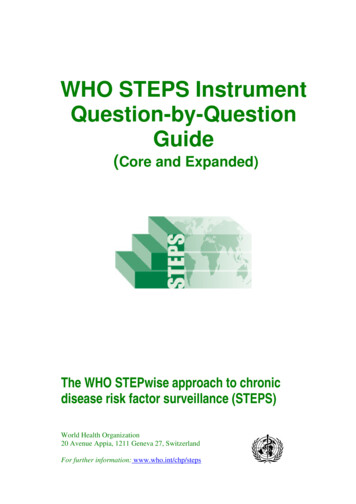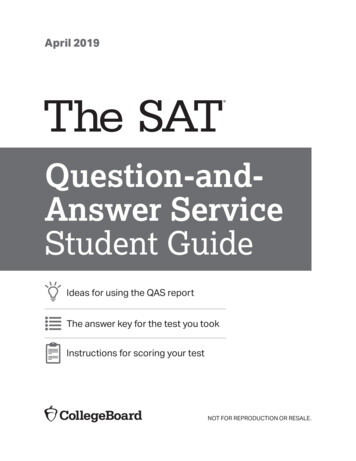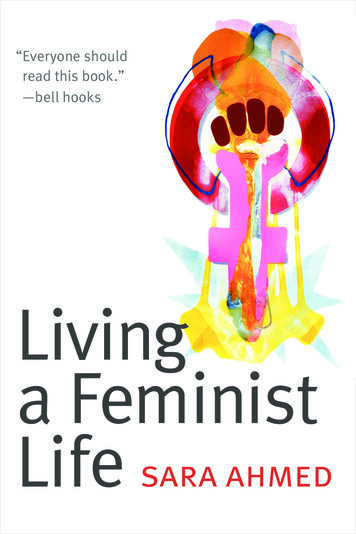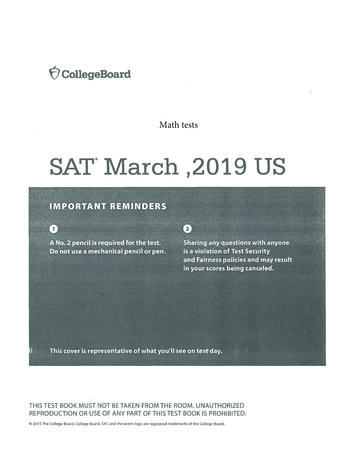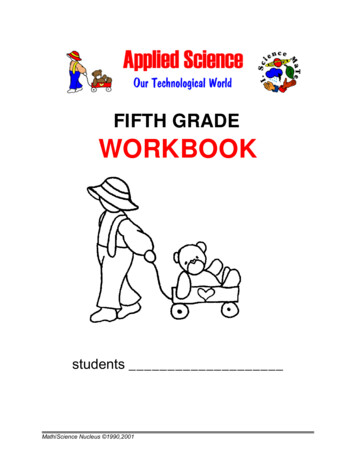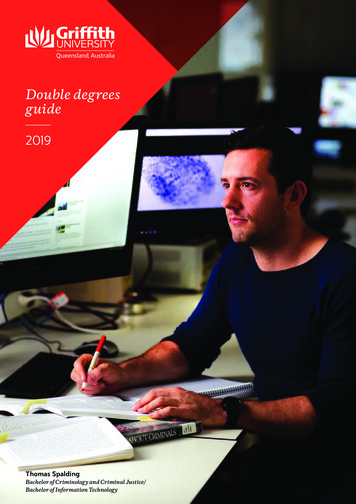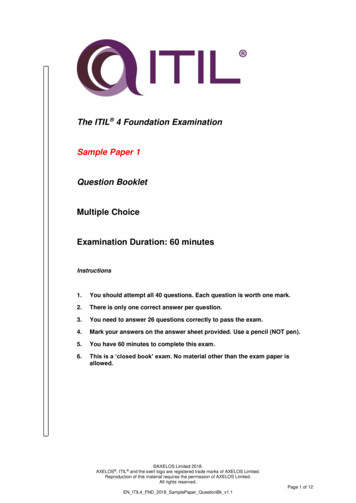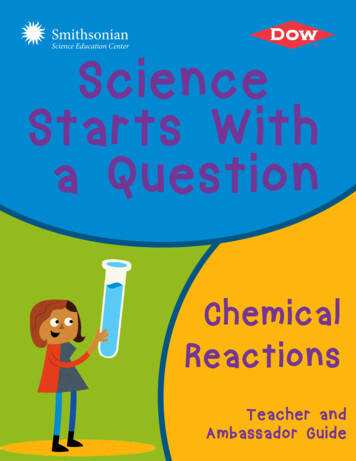
Transcription
ScienceStarts Witha QuestionChemicalReactionsTeacher andAmbassador Guide
Science Starts With a Question is a collaboration between the Smithsonian Science Education Center and TheDow Chemical Company.About the Smithsonian InstitutionThe Smithsonian Institution was created by an Act of Congress in 1846 “for the increase and diffusion ofknowledge ” This independent federal establishment is the world’s largest museum and research complexand is responsible for public and scholarly activities, exhibitions, and research projects nationwide andoverseas. Among the objectives of the Smithsonian is the application of its unique resources to enhanceelementary and secondary education.About the Smithsonian Science Education CenterThe Smithsonian Science Education Center (SSEC) is operated by the Smithsonian Institution to improve theteaching of science in the nation’s schools. The SSEC disseminates information about exemplary teachingresources, develops curriculum materials, and conducts outreach programs of leadership development andtechnical assistance to help school districts implement inquiry-centered science programs. Its mission isto transform the teaching and learning of science in a world of unprecedented scientific and technologicalchange.Smithsonian Science Education Center staff involved in development of this publicationKatya Vines, PhDCurriculum DeveloperBrian Mandell, PhDCurriculum DeveloperClaudia Campbell, Jean Flanagan, Patti MarohnAshley DeeseElizabeth Klemick BrannanTaryn WhiteEditorsDesignerProofreaderProduction SpecialistMarjee Chmiel, PhDAssociate Director for Curriculumand CommunicationsAmy D’Amico, PhDDirector of Professional ServicesEric Nastasi, Esq.Lisa RogersTeng ChamchumrusSenior Advancement OfficerDirector of FinanceInterim DirectorTeachers involved in development of this publicationDavid BrownScience TeacherBullock Creek Middle School, MichiganScott HarrisonScience TeacherFreeland Elementary School, MichiganScience Starts With a Question: Chemical Reactionsi
About The Dow Chemical CompanyDow’s STEM mission is to build the workforce of tomorrow by empowering teachers, motivating studentachievement, developing careers, and collaborating with communities to transform STEM education into adriver for innovation, manufacturing, and economic prosperity.To live out this mission, Dow has created STEMtheGAP — a growing and constantly evolving series ofinitiatives to support and advance STEM education. While stakeholders, target audiences, and focuses mayvary, every initiative is designed to inspire conversation about STEM education, collaboration to developinnovative solutions and, as a result, transformation that will enable our nation and the world to surmountthe challenges of the 21st century.For more information on Dow’s STEMtheGAP initiatives, htmDow staff involved in development of this publicationPatrick Heider, PhDChemical EngineerStephanie HughesChemistTricia WilsonChemical TechnologistCassie Fhaner, PhDChemistMeagan ZabetianSupply Chain AnalystJaime Curtis-Fisk, PhDChemistEvaluation of the safety of chemicals used in this moduleA Safety Data Sheet (SDS) is the main document scientists at Dow use to assess the safety of chemicals. TheSDS lists any hazards associated with the chemical, including potential hazards such as what might happenif the chemical is dropped or if it comes into contact with air or water. Before carrying out an activity, a Dowscientist refers to the SDS for every chemical he or she is going to use. This allows the scientist to decidewhat personal protective equipment to wear and where to carry out the reaction. Dow uses a color-codingsystem for every chemical. All of the chemicals in this module belong to the green category, which is thecategory associated with the lowest level of risk. Appropriate safety precautions recommended by Dow areincluded in the Stay Safe boxes in both the Teacher and Ambassador Guide and the Student Guide. TM Trademark of the Dow Chemical Company (Dow) or an affiliated company of Dow. 2015 Smithsonian InstitutionImage CreditsLuminol Setup – The Dow Chemical CompanyThe illustrations on the cover and chapter opening page are by Tim Bradford.Science Starts With a Question: Chemical Reactionsii
How to Use This GuideWelcome to your Chemical Reactions Teacher and Ambassador Guide! This Guide containsall the information you need to teach the Chemical Reactions module produced by theSmithsonian Science Education Center in partnership with The Dow Chemical Company. Youwill also find background information on all the activities and links to the Next GenerationScience Standards and the Michigan Performance Standards.The following features in this Guide will help you teach this module:What Scientists DoTake opportunities to relate what the students are doing towhat the ambassador scientist does.Stay SafeScience is fun but can also be dangerous. Emphasize safetyadvice to your students.Science Starts With a Question: Chemical Reactionsiii
Science Starts with a QuestionChemicalReactionsModule OverviewStudents will participate in a series of activities based on a model-based inquiry framework.These activities will help them understand the signs that a chemical reaction has taken place.Students will develop a model of an observed phenomenon. Then they will explore theirmodel by observing and carrying out a series of activities. Finally, they will use evidence fromtheir experiences to evaluate and refine their model. They will also use the model to test aprediction. Scientists from Dow Chemical will help students connect what they do in theclassroom to what they may do in a STEM career.LessonLesson 1: ModelDevelopmentActivityBaking soda andcalcium chloridereact in an opensystemLength40 minutesTeaching styleTeacher-guidedstudent activityLesson 2: ModelInvestigationA series of physicalchanges andchemical reactions40 minutesAmbassadordemonstrations andambassador-guidedstudent activitiesLesson 3: ModelEvaluationBaking soda andcalcium chloridereact in a closedsystem40 minutesTeacherdemonstrationScience Starts With a Question: Chemical Reactions1
Module Level Performance ExpectationsThese expectations are based on the Next Generation Science Standards (NGSS)performance expectations for this module. They combine core ideas, practices, andcrosscutting concepts.At the end of this module, students will be able to:tttDevelop a model to describe what happens during a chemical reaction.Compare similarities and differences in data to determine whether a chemical reactionhas taken place.Use a model to predict what will happen when a reaction is carried out in a closed system.Central QuestionHow can I tell if I have made something new?NGSS AlignmentThe NGSS framework combines disciplinary core ideas, crosscutting concepts, andscience and engineering practices. NGSS performance expectations integrate these threeelements. NGSS is designed to be flexible so that teachers can include additional scienceand engineering practices in their instruction. Students will work toward the performanceexpectations listed in this module but will not be expected to achieve them fully until theend of grade 8.Performance ExpectationsMS-PS1-2Analyze and interpret data on the properties of substances before and after the substancesinteract to determine if a chemical reaction has occurred.In Lessons 1 and 2, students look at qualitative data from a series of activities to determinewhether a chemical reaction has taken place.MS-PS1-5Develop and use a model to describe how the total number of atoms does not change in achemical reaction and thus mass is conserved.In Lesson 1, students predict what the change in mass will be if a reaction is carried out in aclosed system. In Lesson 3, the teacher demonstrates the closed system to test the students’predictions.Science Starts With a Question: Chemical Reactions2
Science and Engineering PracticesFocus practicesDeveloping and using modelsDevelop and/or use a model to predict and/or describe phenomena.In Lesson 1, students develop a model to explain what is going on in a chemical reaction. Theyuse the model to make a prediction, which will be tested in Lesson 3.Analyzing and interpreting dataAnalyze and interpret data to determine similarities and differences in findings.In Lesson 2, students analyze qualitative data to decide whether a chemical reaction has takenplace.Engaging in argument from evidenceConstruct, use, and present oral and written arguments supported by empirical evidenceand scientific reasoning to support or refute an explanation or a model for a phenomenon.Respectfully provide and receive critiques about one’s explanations, procedures, modelsand questions by citing relevant evidence and posing and responding to questions thatelicit pertinent elaboration and detail.In Lessons 1 and 3, students engage in argumentation. They defend their explanations andcompare and contrast other students’ explanations with their own.Additional practicesPlanning and carrying out investigationsCollect data to produce data to serve as the basis for evidence to answer scientificquestions or test design solutions under a range of conditions.In Lesson 2, students carry out a series of activities and collect qualitative data as evidence of achemical reaction.Constructing explanations and designing solutionsConstruct an explanation using models or representations.In Lesson 1, students explain their observations from a chemical reaction using their model.Science Starts With a Question: Chemical Reactions3
Disciplinary Core IdeasPS1.A: Structure and properties of matterEach pure substance has characteristic physical and chemical properties (for any bulkquantity under given conditions) that can be used to identify it.In Lessons 1 and 2, students observe the appearance of products compared to reactants.PS1.B: Chemical reactionsSubstances react chemically in characteristic ways. In a chemical process, the atoms thatmake up the original substances are regrouped into different molecules, and these newsubstances have different properties from those of the reactants. The total number of eachtype of atom is conserved, and thus the mass does not change.In Lessons 1 and 2, students observe the four main signs of a chemical reaction: a gas, aprecipitate, a color change, and a temperature change. They should relate these observations toa new substance being produced. In Lesson 3, students observe a reaction carried out in a closedsystem that shows that mass is not lost during a chemical reaction.Crosscutting ConceptsPatternsMacroscopic patterns are related to the nature of microscopic and atomic-level structure.In Lessons 1 and 2, students should relate observations to substances breaking up andreforming as new substances.Energy and matterMatter is conserved because atoms are conserved in physical and chemical processes.In Lesson 3, students should observe that the total mass in a closed system is the same at thestart and end of a reaction.Influence of science, engineering and technology on society and the natural worldThe uses of technologies and any limitations on their use are driven by individual orsocietal needs, desires, and values; by the findings of scientific research; and by differencesin such factors as climate, natural resources, and economic conditions. Thus technology usevaries from region to region and over time.The Extending Your Knowledge section at the end of Lesson 3 discusses the use of sodiumalginate in food science.Science Starts With a Question: Chemical Reactions4
Michigan Department of Education Science Standard AlignmentContent ExpectationsP.CM.07.21Identify evidence of chemical change through color, gas formation, solid formation, andtemperature change.In Lessons 1 and 2, students observe the four main signs of a chemical reaction: a gas, aprecipitate, a color change, and a temperature change. They should relate these observations toa new substance being produced.P.CM.07.23Describe the physical properties and chemical properties of the products and reactants in achemical change.In Lessons 1 and 2, students make observations of the appearance of products compared toreactants.Pre-requisite Knowledge and SkillsBefore starting this module, students should know:tttSubstances are compounds or elements with specific physical and chemical properties(NGSS: 5-PS1-3).Substances are made of particles too small to be seen (NGSS: 5-PS1-1).Physical changes involve particles rearranging themselves but remaining the samechemical substance. In a change of state, particles have less motion (freezing) or moremotion (heating) (NGSS: MS-PS1-4; Michigan: P.CM.06.11).Before starting this module, students should be able to:tttDraw a simple model to explain a phenomenon.Analyze and interpret data to make sense of a phenomenon.Compare and contrast data collected by different groups.Science Starts With a Question: Chemical Reactions5
Module Background InformationIn this series of activities, students will observe the main signs of a chemical reaction. Theseinclude a color change, a precipitate forming, a gas forming, a temperature change, and asmell (although the reactions in this module do not produce a smell). Students should beaware that one of these signs does not definitely indicate that a chemical reaction has takenplace. For example, dry ice in water produces a gas, but this is not a chemical change. Similarly, some compounds produce a temperature change when dissolved in water. However,a temperature decrease as well as a temperature increase can indicate that a chemical reaction has taken place. This is evident in the Crushed Ice activity. Avoid the idea that a physicalchange is reversible and a chemical change is not.MisconceptionsThere are common misconceptions that students of this grade have about chemicalreactions. Research has shown that unless these misconceptions are corrected, studentswill not fully understand new concepts. It is important to identify and correct studentmisconceptions using evidence from the activities.MisconceptionA chemical reaction will produce all foursigns: a temperature change, a gas, a colorchange, and a precipitate.Chemical reactions always produce a gas.CorrectionNo reactions in this module show all foursigns of a chemical reaction.Chemical reactions are always irreversible.Blue Bottle is an example of a reversiblechemical reaction.Chemical reactions require heat to begin.No reactions in this module require heat.All chemical reactions produce heat.The cold pack shows a reaction where thetemperature decreases.Only the reaction of baking soda andcalcium chloride produces a gas.Matter can disappear in a chemical reaction, The reaction of baking soda and calciumespecially in a reaction that produces a gas. chloride in a closed system should show nodecrease in mass.Products result from matter being creatednot rearrangement of bonds in reactants.The reaction of baking soda and calciumchloride in a closed system should show noincrease in mass.Science Starts With a Question: Chemical Reactions6
Teaching Through InquiryIn this module, students answer a central question by collecting evidence from a series ofactivities. The Student Guide gives the procedures for the activities. However, students haveto make decisions on what evidence to collect and how to formulate explanations based onthis evidence. The role of the teacher and the ambassador should be to guide students inthis inquiry. The teacher and ambassador should avoid giving students answers to questions.Instead, they should direct students to relevant observations and prior scientific knowledge.A more open inquiry may develop from questions students raise during this module.Teachers may want to collect these questions on a flip chart or Post-it notes and use them asa basis for a student-designed activity later.Science Starts With a Question: Chemical Reactions7
Lesson 1: Model DevelopmentLesson OverviewStudents will explore the reaction between baking soda and calcium chloride. They shouldobserve a precipitate, a gas, and a small temperature increase. Then they will draw a modelto explain their observations. Finally, they will use their model to predict what will happen ifthe reaction were repeated in a closed system on an electronic balance.Preparation1.2.Hand out a copy of the Student Guide to each student.Arrange the classroom for students to work in groups of four. Ensure each group hasthe materials for their group at their station and access to baking soda, calciumchloride, and distilled water.Let’s Get Started (10 minutes)1.2.3.4.Read the brief overview in the Student Guide together as a class.Have students answer the two questions in Let’s Get Started in the Student Guide.When going through the answers to these questions, reinforce that a physical changeinvolves particles having more movement (heating) or less movement (cooling).Explain to students that they are going to be doing an activity where they mix twosubstances and observe what happens. Remind them to observe very carefully.Stay SafeRemind students of the usual laboratory rules when usingchemicals:r Wear lab-appropriate clothing (closed shoes and longsleeves).r Wear safety goggles at all times.r Always use a spatula to measure solid chemicals.r Be careful when touching anything that may be hot or cold.r Always let the teacher know if any chemicals spill or glassware breaks.r Wash hands immediately with soap and water if anythingspills on hands.r Never taste chemicals.r Smell chemicals by wafting the smell using a hand.Science Starts With a Question: Chemical Reactions8
Reaction of Baking Soda and Calcium Chloride (25 minutes)Activity Background InformationThe equation for the chemical reaction is:2NaHCO3 CaCl2CaCO3 CO2 2NaCl H2OCalcium carbonate is insoluble in water; therefore, it appears as a precipitate. Sodiumchloride is also produced. However, it is insoluble in water, so it remains in solution. Thebubbles observed are carbon dioxide. The reaction is exothermic because more energy isgiven out by bond making than is needed for bond breaking.MaterialsFor each studentSafety gogglesDisposable glovesFor each group of four students2 Beakers (50 mL)1 Graduated cylinder (25 mL)1 Thermometer1 SpatulaPen or labelsFor groups to shareCalcium chlorideBaking sodaDistilled waterProcedureStay SafeMake sure students don’t use the thermometer to stir thesolution, as this may break the thermometer.1.2.Let students know where they can find the baking soda and calcium chloride.Have students add a spatula of calcium chloride to one beaker followed by 25 mL ofwater and stir until most of the calcium chloride dissolves. It is not important that all ofthe calcium chloride dissolves.Science Starts With a Question: Chemical Reactions9
3.4.5.6.7.8.Have students add a spatula of baking soda to one beaker followed by 25 mL of waterand stir until most of the baking soda dissolves. It is not important that all of thebaking soda dissolves.At this point, have students write down the appearance of the starting materials inquestion 1 of What Is Going On. They should describe the two solutions rather than thesolids.Have students put the thermometer in the calcium chloride solution and take thetemperature.Have students slowly add the baking soda solution to the calcium chloride solutionand write down their observations in question 2 of What Is Going On.At the end of the experiment, tell students to dispose of the chemicals using theprocedure followed in your school.Have students complete questions 3-6 of What Is Going On.Teaching Notes1.2.3.4.Make sure students label each beaker before mixing the solutions.Students should observe a white precipitate, gas bubbles, and a temperature increaseof a few degrees.Drawing the model should be an individual activity. Take care not to give studentstoo much information at this stage. Students can use any kind of drawing to explainthe observations and should be encouraged to use arrows and symbols. You may needto prompt students to use labels and/or a key so that their model is clear.After students have drawn their model, select some students to explain their model tothe class. Encourage students to support their model using evidence from theexperiment. Students should compare and contrast models. Lead a discussion aboutwhich model best fits the evidence. If students haven’t had experience inargumentation, this discussion will need to be carefully moderated. Ensure thatstudents listen respectfully and use evidence to support their argument.What Scientists DoThis is a good opportunity to stress the importance ofcommunication in science. Scientists collaborate with otherscientists to share ideas and challenge each other’s ideas. Theydefend their ideas, but they are open to other ideas supportedby evidence. This advances scientific understanding.5.In question 4, students should explain that a gas is being produced by the reaction ofbaking soda with another ingredient in the cake.Science Starts With a Question: Chemical Reactions 10
6.7.In question 5, students should know that particles can move more easily in a liquid.This increases the chances of them bumping into each other and forming newsubstances.Students may need some help visualizing the reaction in a closed system (question 6).It might be helpful for these students to draw a simple sketch of the apparatus.Review (5 minutes)1.2.Students should know that a precipitate, a gas, and a temperature change are all signsthat a chemical reaction has taken place and new substances have been formed.At the end of the lesson, let students know that a scientist from Dow will be visitingfor the next lesson. Tell them that they will be using their model to explore more typesof chemical reaction.Science Starts With a Question: Chemical Reactions 11
Lesson 2: Model InvestigationLesson OverviewIn this lesson, students will watch the ambassador carry out three short demonstrations. Twoactivities will show a physical change and one will show a chemical reaction. Then studentswill carry out four activities themselves. They will use their observations to decide whether achemical reaction has taken place. Throughout, students will collect evidence that will helpthem explore their model and reflect on their prediction from Lesson 1.Activity titleFog MakerStarting materialsDry ice and waterType of changePhysical change(sublimation)Teaching styleAmbassadordemonstrationCrime SceneInvestigationLuminol and bleachChemical reaction(color change)AmbassadordemonstrationInvisible ShelfDry ice and bubblesPhysical change(sublimation)AmbassadordemonstrationBlue BottleGlucose andmethylene blueChemical reaction(color change)Ambassador-guidedstudent activityMagic Jell-OMethocelPhysical change(solid formation onheating)Ambassador-guidedstudent activityCrushed IceInstant cold packsChemical ent activityWater SnakesSodium alginate andcalcium chlorideChemical reaction(solid formation)Ambassador-guidedstudent activityScience Starts With a Question: Chemical Reactions 12
Recommended Roles for Ambassador and TeacherThe table below provides suggestions for the role of the ambassador and teacher during thislesson. The ambassador and teacher should discuss this table before the lesson and modifyas appropriate to their preferences and needs.TeacherAmbassadorPreparationr Set up classroom forr Contact teacher todemonstration and grouparrange time and locationworkfor set upr Prepare materials forr Ensure all materials arestudent experiments andprepared and ready forput them on workstationstransportationr Set up materials fordemonstrationsLet’s Get Startedr Introduce ambassadorr Lead the Let’s Get Startedactivityr Explain what will happenduring the lessonr Explain the role of a DowSTEM ambassadorr Remind students of safetyrules in the laboratoryActivityr Maintain classroomprocedures and discipliner Keep lesson on trackr Assist students withactivities, providingguidance but no answersr Ensure students followsafety proceduresr Ensure students followclean up and disposalprocedures correctlyr Demonstrate experimentsr Assist students withexperiments, providingguidance but no answersr Ensure students followsafety proceduresr Advise students ondisposal proceduresr Make connectionsbetween the activitiesand what scientists dor Answer questions fromstudents about his/herjobScience Starts With a Question: Chemical Reactions 13
Reviewr Lead the Review activityr Explain what he/she doesr Thank the ambassador forand relate it to scientifichis/her timepractices that studentsused in the lessonReturn of materialsr Ensure all materials areready for collectionr Pick up materials andcheck everything hasbeen returnedr Let relevant Dow staffknow if any materialshaven’t been returned orhave been damagedPreparation1.2.3.4.5.Make up a solution of luminol by dissolving 0.4 g of luminol and 4 g of sodiumhydroxide in 1 L of water. Make a solution of household bleach by dissolving 100 cm3of bleach in 900 cm3 of water.Arrange the classroom with a suitable area to set up and conduct the demonstrations.Set up the materials for the Crime Scene Investigation demonstration as in the imagebelow, with the luminol solution in one separating funnel and the bleach solution inanother.Arrange the classroom for students to work in pairs.Put the materials for Blue Bottle, Magic Jell-O, and Crushed Ice on each workstation.Pour 25 mL of 2% sodium alginate solution into a 50 mL beaker for each pair ofstudents and label it ”sodium alginate solution.” Make up a solution of calciumchloride by dissolving 100 g of calcium chloride in 2 L of water. Pour 125 mL of theScience Starts With a Question: Chemical Reactions 14
calcium chloride solution into a 250 mL beaker for each pair of students and label it”calcium chloride solution.” Put a beaker of each solution on each workstation.NoteRefrigerate sodium alginate to prevent mold.Let’s Get Started (5 minutes)1.2.3.4.The teacher should introduce the ambassador (without giving away his/her job title orwhat he/she does). The ambassador should explain what a Dow STEM ambassadordoes.The teacher should ask the students to write down the ambassador’s name and whatthey think a scientist does in a typical working day.The teacher should explain the structure of the day and the role of the ambassador.The teacher should refer the students to the questions in the Review section andencourage students to find out what the ambassador does while they are carrying outtheir activities.The ambassador should remind students of the laboratory safety rules.What Scientists DoThe ambassador could talk briefly about the importance ofsafety at Dow and that the procedures that students follow tostay safe are the same procedures that scientists at Dow follow.The ambassador could also mention that Dow has assessed thesafety of all the chemicals used in the day’s lesson and eventhough the safest chemicals have been chosen, students stillneed to follow the usual laboratory rules.Fog Maker (2 minutes)NoteBefore starting Fog Maker, put 5 or 6 pieces of dry ice (solid carbon dioxide) into the aquarium to sublime for Invisible Shelf. Make sure students know you are doing this.Science Starts With a Question: Chemical Reactions 15
Activity Background InformationDry ice has a temperature of –78.5 C (–109.3 F). At temperatures above 56.4 C ( 69.5 F),it sublimes into carbon dioxide gas without passing through the liquid phase. Dry ice willsublime quickly when dropped into warm water. Gas rises out of the container. As carbondioxide is denser than air, the gas falls over the side of the container to the floor.MaterialsFor the ambasssadorAn insulated glove2 Small pieces of dry ice1 Graduated cylinder (1 L) filled with about 300 mL of hot tap waterProcedureStay SafeAlways handle dry ice with thick gloves. Tell students thatholding dry ice for several seconds without hand protection willcause a severe burn similar to grabbing hold of a hot tray froman oven.1.2.Put the pieces of dry ice into the cylinder of warm water.Have students complete the table in What Is Going On.Teaching Notes1.2.3.4.Show students the dry ice and explain that it is carbon dioxide in a solid state.Students should observe gas rising upwards rapidly and then falling down to theground when the ambassador adds dry ice to the water.Ask students what they think the gas is and whether they think this is a physicalchange or a chemical reaction.Explain why this is a physical change.What Scientists DoExplain what dry ice is used for in industry, e.g., keepingreactions very cold.Science Starts With a Question: Chemical Reactions 16
Crime Scene Investigation (5 minutes)Activity Background InformationIn this reaction, luminol is oxidized by bleach. The oxidized form is in an excited state andgives out energy as light. This is an example of chemiluminescence. Bioluminescence ischemiluminescence in a living organism. Students are likely to know fireflies are an exampleof bioluminescence. However, there are many other organisms that exhibit bioluminescence,particularly in deep water.Luminol can also be oxidized by hydrogen peroxide, with a catalyst. This is used in forensicscience where the iron in haemoglobin catalyzes chemiluminescence. This causes a glow inareas where there is blood (see Did You Know feature in this section).MaterialsFor the ambassadorHousehold bleach solution (500 mL)Luminol solution (500 mL)1 Piece of transparent plastic tubing (1 m)2 Separating funnels (500 mL)1 Large funnel1 Graduated cylinder (1 L)1 Bath (1 L)1 Retort stand2 Retort rings1 ClampProcedure1.2.Slowly open the taps to the two separating funnels so the luminol and bleachsolutions pour into the large funnel at the same rate. It should take approximately 30seconds for the two separating funnels to empty
Science Starts With a Question: Chemical Reactions i Science Starts With a Question is a collaboration between the Smithsonian Science Education Center and The Dow Chemical Company. About the Smithsonian Institution The Smithsonian Institution was created by an Act of Congress in 1846 "for the increase and di!usion of knowledge "
